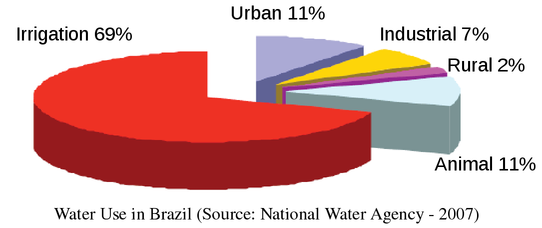6. Water - For what?
All organisms need water to survive, and its availability a key factor in structuring an ecosystem.
So it is essential that water resources have physical and chemical conditions suitable for their use by the living organisms.
 | But! -the World Health Organisation (WHO) estimates that 3.4 million people die from water, sanitation and hygiene-related causes each year. (Source: http://water.org/water-crisis/water-facts/water/) -1.1 billion people has no access to any type of improved drinking source of water. (Source: http://www.who.int/water_sanitation_health/mdg1/en/index.html) AVAILABILITY = QUANTITY + QUALITY |
In Brazil, for example, the most intensive use of water is irrigation for food production (69%), 11% for urban water supply, 11% for animal watering, 7% for industrial use and 2% for rural supplies.
6.1. Water Use in Industry
The industrial use of water depends basically on the following factors:
Sector of business activity -> Water quality (suitable for the intended purposes).
Production capacity -> Quantity of water - current and future availability, flow and pressure necessary for the normal and extreme conditions (peak usage)
Main uses of water in industries:
Raw material (eg: beverages and soft drinks, toiletries, food and pharmaceutical).
Quality equivalent or superior to the quality of water used for human consumption.
Auxiliary fluid (eg: preparation of suspensions and solutions, intermediate compounds, and cleaning operations).
Quality depends on the process, without contact with the finished product the quality level is less restrictive.
Obtain energy by converting:
-Kinetic or potential energy (hydroelectric), least restrictive level of quality
-Thermal energy (steam turbines), more restrictive level of quality.
Heat transfer fluid
Water for steam production, more restrictive quality grade
Water for cooling, quality grade less restrictive
